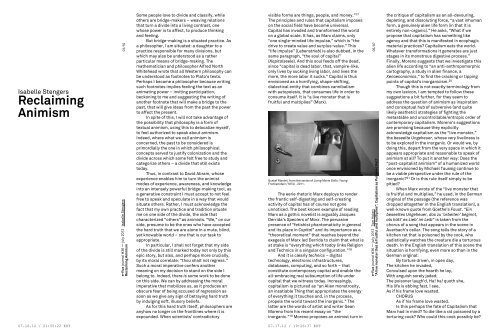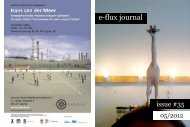You also want an ePaper? Increase the reach of your titles
YUMPU automatically turns print PDFs into web optimized ePapers that Google loves.
Isabelle Stengers<br />
Reclaiming<br />
<strong>Animism</strong><br />
07.16.12 / 21:55:22 EDT<br />
01/10<br />
e-flux journal #36 — july 2012 Isabelle Stengers<br />
Reclaiming <strong>Animism</strong><br />
Some people love to divide and classify, while<br />
others are bridge-makers – weaving relations<br />
that turn a divide into a living contrast, one<br />
whose power is to affect, to produce thinking<br />
and feeling.<br />
But bridge-making is a situated practice. As<br />
a philosopher, I am situated: a daughter to a<br />
practice responsible for many divisions, but<br />
which may also be understood as a rather<br />
particular means of bridge-making. The<br />
mathematician and philosopher Alfred North<br />
Whitehead wrote that all Western philosophy can<br />
be understood as footnotes to Plato’s texts.<br />
Perhaps I became a philosopher because writing<br />
such footnotes implies feeling the text as an<br />
animating power – inviting participation,<br />
beckoning to me and suggesting the writing of<br />
another footnote that will make a bridge to the<br />
past, that will give ideas from the past the power<br />
to affect the present.<br />
In spite of this, I will not take advantage of<br />
the possibility that philosophy is a form of<br />
textual animism, using this to delocalize myself,<br />
to feel authorized to speak about animism.<br />
Indeed, where what we call animism is<br />
concerned, the past to be considered is<br />
primordially the one in which philosophical<br />
concepts served to justify colonization and the<br />
divide across which some felt free to study and<br />
categorize others – a divide that still exists<br />
today.<br />
Thus, in contrast to David Abram, whose<br />
experience enables him to turn the animist<br />
modes of experience, awareness, and knowledge<br />
into an intensely powerful bridge-making tool, as<br />
a generative constraint I must accept to not feel<br />
free to speak and speculate in a way that would<br />
situate others. Rather, I must acknowledge the<br />
fact that my own practice and tradition situate<br />
me on one side of the divide, the side that<br />
characterized “others” as animists. “We,” on our<br />
side, presume to be the ones who have accepted<br />
the hard truth that we are alone in a mute, blind,<br />
yet knowable world – one that is our task to<br />
appropriate.<br />
In particular, I shall not forget that my side<br />
of the divide is still marked today not only by this<br />
epic story, but also, and perhaps more crucially,<br />
by its moral correlate: “thou shalt not regress.”<br />
Such a moral imperative confers another<br />
meaning on my decision to stand on the side I<br />
belong to. Indeed, there is some work to be done<br />
on this side. We can by addressing the moral<br />
imperative that mobilizes us, as it produces an<br />
obscure fear of being accused of regression as<br />
soon as we give any sign of betraying hard truth<br />
by indulging soft, illusory beliefs.<br />
As for this hard truth itself, philosophers are<br />
anyhow no longer on the frontlines where it is<br />
expounded. When scientists’ contradictory<br />
visible forms are things, people, and money.” 17<br />
The principles and rules that capitalism imposes<br />
on the social field have become universal.<br />
Capital has invaded and transformed the world<br />
on a global scale. It has, as Marx claims, only<br />
“one single-minded life impulse,” which is “the<br />
drive to create value and surplus-value.” This<br />
“life impulse” (Lebenstrieb) is also dubbed, in the<br />
same paragraph, “the soul of capital”<br />
(Kapitalseele). And this soul feeds off the dead,<br />
since “capital is dead labor, that, vampire-like,<br />
only lives by sucking living labor, and lives the<br />
more, the more labor it sucks.” Capital is thus<br />
envisioned as a horrifying, shape-shifting,<br />
dialectical entity that combines cannibalism<br />
with autopoiesis, that consumes life in order to<br />
consume itself. It is “a live monster that is<br />
fruitful and multiplies” (Marx).<br />
Gustaf Mantel, from the series of Living Movie Stills: Young<br />
Frankenstein (1974) , 2011.<br />
The eerie rhetoric Marx deploys to render<br />
the frantic self-digesting and self-creating<br />
activity of capital has of course not gone<br />
unnoticed. The best known example of reading<br />
Marx as a gothic novelist is arguably Jacques<br />
Derrida’s Specters of Marx. The pervasive<br />
presence of “fetishist phantomaticity in general<br />
and its place in Capital” and its importance as a<br />
“theoretical moment” that reaches beyond the<br />
exegesis of Marx led Derrida to claim that what is<br />
at stake is “everything which today links Religion<br />
and Technics in a singular configuration.” 18<br />
And it is clearly technics – digital<br />
technology, electronic infrastructures,<br />
databases, computing, and so forth – that<br />
constitute contemporary capital and enable the<br />
all-embracing real subsumption of life under<br />
capital that we witness today. Increasingly,<br />
capitalism is pictured as “an Alien monstrosity,<br />
an insatiable Thing that appropriates the energy<br />
of everything it touches and, in the process,<br />
propels the world toward the inorganic.” The<br />
latter are the words of artist and writer Gean<br />
Moreno from his recent essay on “the<br />
inorganic.” 19 Moreno proposes an animist turn in<br />
07.17.12 / 19:26:37 EDT<br />
05/07<br />
e-flux journal #36 — july 2012 Tom Holert<br />
“A live monster that is fruitful and multiplies”: Capitalism as Poisoned Rat?<br />
the critique of capitalism as an all-devouring,<br />
depleting, and dissoluting force, “a vast inhuman<br />
form, a genuinely alien life form (in that it is<br />
entirely non-organic).” He asks, “What if we<br />
propose that capitalism has something like<br />
agency and that this is manifested in ecophagic<br />
material practices? Capitalism eats the world.<br />
Whatever transformations it generates are just<br />
stages in its monstrous digestive process.”<br />
Finally, Moreno suggests that we investigate this<br />
alien life according to “an anti-anthropomorphic<br />
cartography, a study in alien finance, a<br />
Xenoeconomics,” to find the cracking or tipping<br />
points of capital’s inorganicism. 20<br />
Though this is not exactly terminology from<br />
my own lexicon, I am tempted to follow these<br />
suggestions a bit further, for they seem to<br />
address the question of animism as inspiration<br />
and conceptual hub of subversive (and quite<br />
likely aesthetic) strategies of fighting the<br />
metastable and uncontrollable/entropic order of<br />
contemporary capitalism. Moreno’s suggestions<br />
are promising because they explicitly<br />
acknowledge capitalism as the “live monster,”<br />
the beseelte Ungeheuer, whose very liveliness is<br />
to be explored in the inorganic. Or would we, by<br />
doing this, depart from the very space in which it<br />
appears appropriate and reasonable to speak of<br />
animism at all? To put it another way: Does the<br />
“post-capitalist animism” of a humanized world<br />
once envisioned by Michael Taussig continue to<br />
be a viable perspective under the rule of the<br />
inorganic? 21 Or is this rule itself simply to be<br />
pitied?<br />
When Marx wrote of the “live monster that<br />
is fruitful and multiplies,” he used, in the German<br />
original of the passage (the reference was<br />
dropped altogether in the English translation), a<br />
well-known quote from Goethe’s Faust. “Ein<br />
beseeltes Ungeheuer, das zu ‘arbeiten’ beginnt,<br />
als hätt’ es Lieb’ im Leib” is taken from the<br />
chorus of a song that appears in the scene in<br />
Auerbach’s cellar. The song tells the story of a<br />
kitchen rat that is poisoned by the cook, who<br />
sadistically watches the creature die a torturous<br />
death. In the English translation of this scene the<br />
situation is horrifying, even more so than in the<br />
German original:<br />
By torture driven, in open day,<br />
The kitchen he invaded,<br />
Convulsed upon the hearth he lay,<br />
With anguish sorely jaded;<br />
The poisoner laugh'd, Ha! ha! quoth she,<br />
His life is ebbing fast, I see,<br />
As if his frame love wasted.<br />
CHORUS<br />
As if his frame love wasted.<br />
Is this perhaps the fate of Capitalism that<br />
Marx had in mind? To die like a rat poisoned by a<br />
torturing cook? Who could this cook possibly be?









